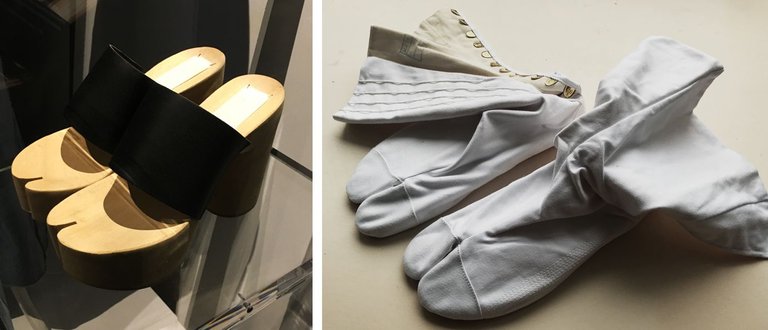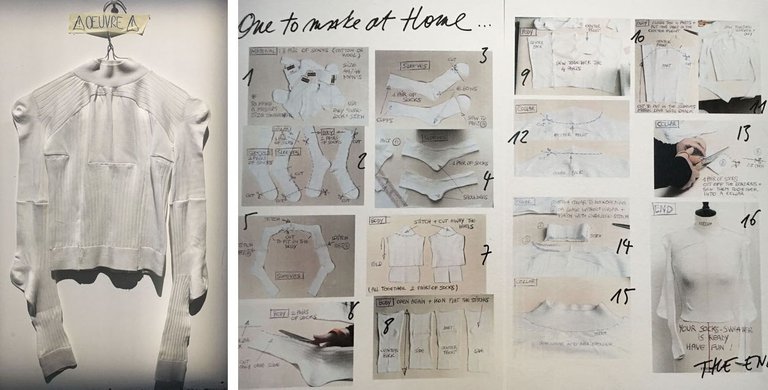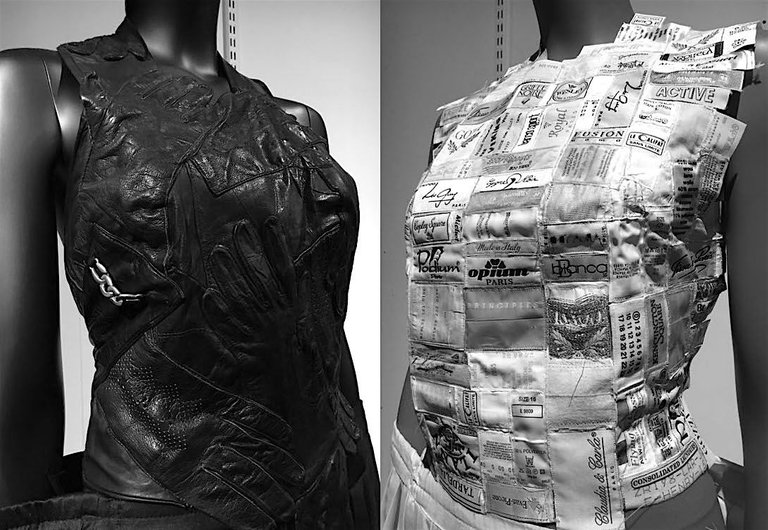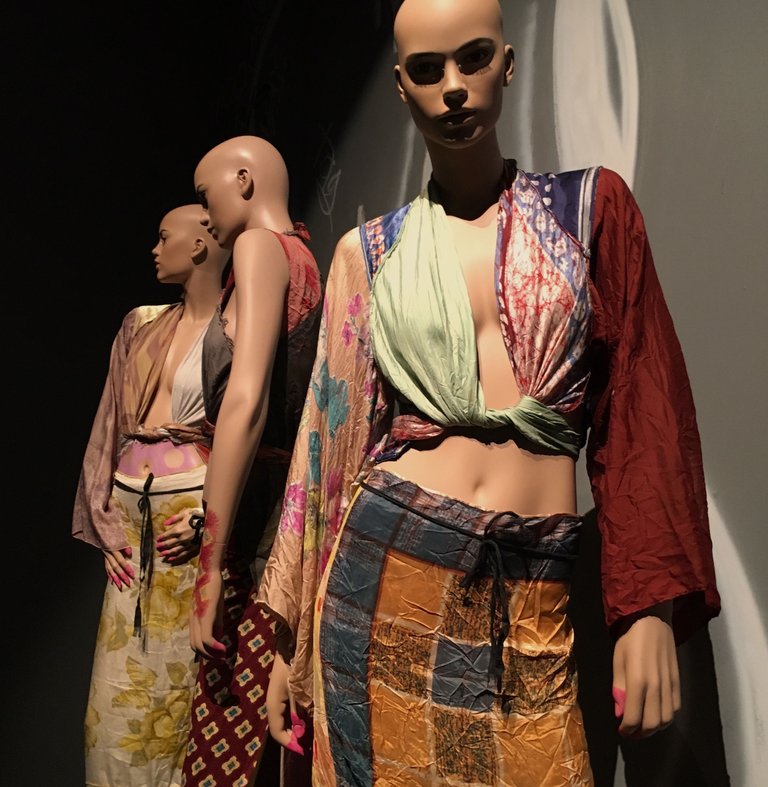There are currently two exhibitions in Paris dedicated to Belgian designer Martin Margiela.
One in the Musées des Arts Décoratifs is happening until September and concerns with Margiela's work at Hermès (1997-2003). The other exhibition is a retrospective of his own label from 1989-2009, taking place in Palais Galliera until July, whose creative director is Margiela himself.
Margiela, An Anonymous
Sunday's visit to Galliera shown as pretty crowded one and those light bulbs that produced extra heat weren't making things more pleasant. People in Paris use holidays, Sundays, and any form off-days to visit places, not to enjoy their home. Right at the entrance, appeared label's iconic item - Tabi shoe. This is kind of an 'ugly' shoe that is so ugly that you'll eventually love it. It is made after Japanese Jika-tabi sock-booties, the ones worn by ninja, that inspired a birthday gift for a Jake, a person in love in all things Japanese. A seller on eBay stated that the expected delivery is in 3 weeks, but the sock-booties came in 7days. That's the Japanese thing.
Tabi’s separated toes improve on balance, and Margiela was about to discover that only a couple of years later after he launched them, it is always nice to be surprised with such 'extra' value. Jake said he could do his Tai Chi in them.

Left: Margiela's Tabi will transform multiple times over his career. Right: Jika-tabi sock booties from eBay. I might get one too, hm...
His first collection was a bit boring from today's perspective, at this point we have seen enough of deconstructivist all kinds of attempts to play it artistic... But after I saw the whole exhibition, the context, I appreciated everything much more. In the Margiela code I discovered deconstructivist's poem:
''Show darts to articulate the shape of each garment
Wash clothes to rid them of their newness
Repurpose objects to serve as an accessory
Utilise elements from the previous collections''
He did exactly that - showed 'technical' and 'vulnerable' side of clothes, making them inside out, like when you are preparing them for washing - showed the tailor’s weak spots, the darts; made them looking worn as nothing can damage it anymore; creased them instead of steaming them... Those tiny lining dresses were now the main garment and not the undergarment. Overdyed all and saw the things from different perspective, literally - rotated the angle by 45 or 90 degrees.
The things I love about this designer the most:
No one knows who he is.
Well played - fewer distractions, a sharper focus on what is important. Bizarre headlines like ''A man from the shadow on the head of Parisian couture'', I imagine those lines in stupid, overly sensationalistic media.Calm manner & resourcefulness
When he’d run out of time for the runway show, there was no stress. There is still buttoning left to complete? Do it with the duct tape. No fundings for a new collection? - Why should it be new? Let's gather all the trash anyone has and make some magic out of it.
‘Artisanal’ line
The AHA moment of the exhibition when I really started to enjoy the work, was seeeing the sock sweater. Margiela didn't have the knitter, so he employed his mother to knit for him - on the broomsticks. The result was ugly sweaters you can find today in any run-down designer's store. Next, he did a sweater made os socks found in a military surplus store in the US, now I am thinking how did he came to the US if there wasn't enough of funds for the line, well I guess we all have different priorities. Well figured positioning made the heels of the sock matching the joints - elbows and shoulders. A good guy Margiela shared DIY tutorial for all those who want to try this at home.

Sock sweater directions
Flea market scarves as fabric for SS collection
Soon, his dadaist/deconstructivist approach to clothing making got him in 1990 ANDAM award and funding the ‘Artisanal’ line followed. ‘Artisanal’ line items appeared in the form of spontaneous impulses (exactly my approach to design! AHA moments? Thank you so much for making my life special!) made by hand out of transformed, already existent garments bought in the flea markets. ‘Artisanal’ became haute couture. Oui, exactement, flea market to haute couture trough hands of this Margiela guy.
He continued... blouse made from of the etiquettes and from gloves. A jeans jacket and trousers combined together to make a coat, très sexy summer collection made out of those ugly flea market scarves. Again, those Frankenstein's monster clothes were haute couture.

Gloves and ettiquette blouses
Ideas as impulse
Margiela collections were narrative serials, a motif from the previous collection continued transformed in the anticipating one. Let's take paper patterns (first, you do tailoring pattern in paper, then in fabric - which isn't always the case) we have from the previous season and make a garment that can be laid entirely flat, just like a pattern. To avoid volume armholes and collars should be displaced. Or let's take the plastic bag from the SS collection and reinterpret it in the fabric as dress and blouse in FW collection. Margiela didnt like labeling his clothes, neither did he liked loud logos.
As the exhibition progressed, more great ideas popped up, and I guess whatever you do with passion, you get caught in the flow and things just unfold seamlessly. I saw black and white photos of vintage garments, printed on garments - trompe o'leil images on simple cuts.
He is original, no doubt about it, and his influence is up today widespread, people are afraid of their humanness and Margiela being just stressfree and himself. So adorable. Quilted jackets Demna Gvasalia? Margiela joined a down comforter and sleeves, and you can bring your bedware to work in merciless winter’s days. It could be worn alone or inside a duvet cover made of flowered sheets of 1970’s, or khaki military blankets, or a cover in opaque PVC as a rain protector. Transparent 'no shoe' look Yeezy? Tabi sole + transparent scotch tape. Ha-ha.
Down comforter coats
Another best thing of the exhibition is an interesting installation inspired by the series of photographs by Kiyochi Tsuzuki, Happy Victims in 2008. The installation shows the living spaces of Japanese youth, which instantly recalled memories of beloved Tokyo to my intellect - cramped studios with a bunch of clothing and accessory from a single designer. Presented Margiela's works in this ‘collect them all’ manner makes you want to do just that.

Happy victims, 2008.
When Margiela first started he did not have a lot of economic resources, but he showed everyone, especially young people that some other resources as imagination is so much more important.


I gave you an upvote!
Please give me a follow and take a moment to read this post regarding commenting and spam.
(tl;dr - if you spam, you will be flagged!)✅ @katarinabar, congratulations on making your first post!